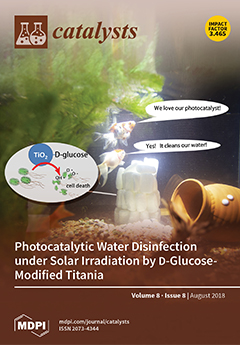In this work, plasma-catalytic removal of H
2S over La
xMnO
3 (
x = 0.90, 0.95, 1, 1.05 and 1.10) has been studied in a coaxial dielectric barrier discharge (DBD) reactor. The non-stoichiometric effect of the La
xMnO
3
[...] Read more.
In this work, plasma-catalytic removal of H
2S over La
xMnO
3 (
x = 0.90, 0.95, 1, 1.05 and 1.10) has been studied in a coaxial dielectric barrier discharge (DBD) reactor. The non-stoichiometric effect of the La
xMnO
3 catalysts on the removal of H
2S and sulfur balance in the plasma-catalytic process has been investigated as a function of specific energy density (SED). The integration of the plasma with the La
xMnO
3 catalysts significantly enhanced the reaction performance compared to the process using plasma alone. The highest H
2S removal of 96.4% and sulfur balance of 90.5% were achieved over the La
0.90MnO
3 catalyst, while the major products included SO
2 and SO
3. The missing sulfur could be ascribed to the sulfur deposited on the catalyst surfaces. The non-stoichiometric La
xMnO
3 catalyst exhibited larger specific surface areas and smaller crystallite sizes compared to the LaMnO
3 catalyst. The non-stoichiometric effect changed their redox properties as the decreased La/Mn ratio favored the transformation of Mn
3+ to Mn
4+, which contributed to the generation of oxygen vacancies on the catalyst surfaces. The XPS and H
2-TPR results confirmed that the Mn-rich catalysts showed the higher relative concentration of surface adsorbed oxygen (O
ads) and lower reduction temperature compared to LaMnO
3 catalyst. The reaction performance of the plasma-catalytic oxidation of H
2S is closely related to the relative concentration of O
ads formed on the catalyst surfaces and the reducibility of the catalysts.
Full article





